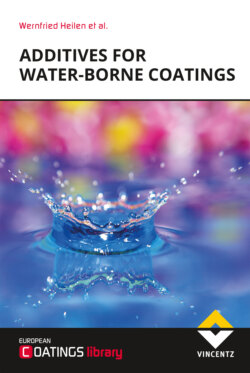Читать книгу Additives for Waterborne Coatings - et al. - Страница 52
На сайте Литреса книга снята с продажи.
Macro-foam
ОглавлениеMacro- or surface foam is the type visible on the surface. In macro-foam the bubble is separated by a thin foam lamella from the surrounding atmosphere. The surfaces of the lamella orientated to the atmosphere and to the gas bubble are covered with a layer of surfactant. This double surfactant layer is frequently called a duplex film.
Figure 3.1: Formation and stabilisation of foam in a liquid. Micro-foam is stabilised by a single surfactant layer in the bulk phase of the liquid. Foam bubbles penetrating through the surface appear as macro foam and are stabilised by a double layer of surfactants, the so-called duplex film.
Macro-foam can be further differentiated by the liquid content of the lamella. Freshly formed macro-foam created by rising bubbles consists of spherical bubbles, which are stabilised by thick lamellas with high water content. This foam is described as ball foam. Due to gravity-induced drainage, the water in the foam lamellas flows down until the bubbles are stabilised by very thin, but very stable lamellas. In this process the original spherical bubbles are transformed into a more stable polyhedral form. The resulting foam consists of a great deal of gas and little liquid and is also known as dry foam or polyhedral foam [1] [4] [5] [6].
Figure 3.2: Structure of foam
Ball foam can be differentiated from polyhedral foam according to the volume content of gas as shown in Table 3.1 In gas dispersions the volume content of the gas is characteristically higher than the volume content of water.
| Table 3.1: Volume content of gas in foams [7] | |
| φ = Vg / (Vg + Vl) | |
| Gas dispersion | φ = 0.52 |
| Ball foam | 0.52 < φ < 0.74 |
| Polyhedral foam | φ > 0.74 |
| Vg = Volume of gas, Vl = Volume of liquid |
